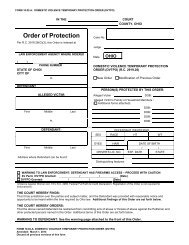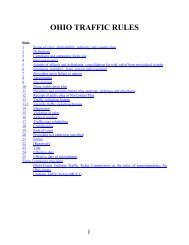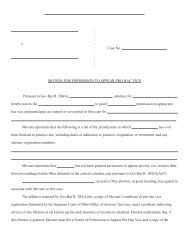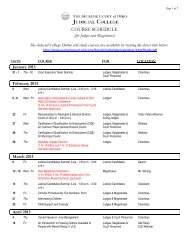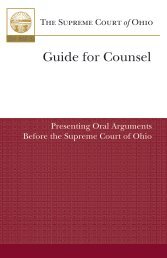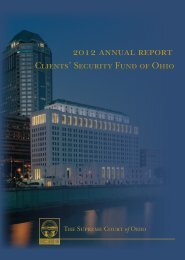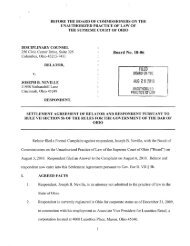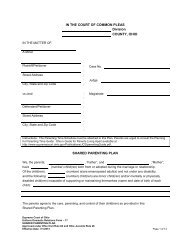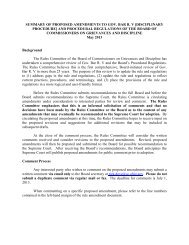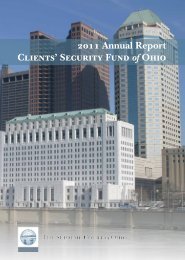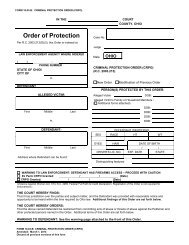disciplinary handbook: volume v - Supreme Court - State of Ohio
disciplinary handbook: volume v - Supreme Court - State of Ohio
disciplinary handbook: volume v - Supreme Court - State of Ohio
You also want an ePaper? Increase the reach of your titles
YUMPU automatically turns print PDFs into web optimized ePapers that Google loves.
Lentes, Disciplinary Counsel v.120 <strong>Ohio</strong> St.3d 431, 2008-<strong>Ohio</strong>-6355. Decided 12/11/2008.Case Summaries- 179Respondent systematically deceived three separate clients through lies about fictitious complaints,hearings, and other legal proceedings, including fabricating a judgment entry and forging a judge‘ssignature. Respondent failed to answer the complaint. As a result, relator moved for default perGov.Bar R. V(6)(F). A master commissioner, appointed by the board, granted the motion for default,made findings <strong>of</strong> fact, conclusions <strong>of</strong> law, and recommended permanent disbarment. The six-countcomplaint came from respondent‘s dealings with three individual clients. In Count I, respondent washired by Greg Garretson in November 2004 in a dispute over repairs <strong>of</strong> a motorcycle with a HarleyDavidson dealership. Respondent promised to file a lawsuit and advised he would recover his legal feesthrough litigation. Although he failed to settle the dispute, he never filed a complaint. In fact,respondent did little but lie to Garretson. Respondent had Garretson attend fictitious hearings, keepingGarretson waiting outside the courtroom. Respondent had Garretson hire an expert, who inspected themotorcycle and created a report to use at trial. Respondent held conferences with Garretson at least fourtimes, once for the purpose <strong>of</strong> preparing him for trial. He lied about receiving a judgment inGarretson‘s favor, lied about delivery <strong>of</strong> the motorcycle and eventual monetary award, and fabricated ajudgment entry, forging a judge‘s signature. Garretson learned <strong>of</strong> the fabrication and forgery in May2007, when he checked with the common pleas court and was told that respondent had never even filedthe complaint on his behalf. The board found respondent violated Pr<strong>of</strong>.Cond.R. 8.4(c), 8.4(d), and 8.4(h)and their respective predecessors DR 1-102(A)(4), (5), and (6), as well as Pr<strong>of</strong>.Cond.R. 1.1 and 1.3 andits predecessor DR 6-101(A)(3). In Count III, Jerry and Wanda Searles hired respondent in September2005 to handle the adoption <strong>of</strong> their teenage grandson in the Meigs County Probate <strong>Court</strong>. They paidrespondent $500 in legal fees and $250 for court costs. The Searles were told respondent filed theiradoption petition in November 2005, but he did not actually file the petition until August 1, 2006.Respondent ignored the Searles despite numerous messages and phone calls. He had them attend afictitious hearing on May 19, 2006, where he failed to appear. He then refused to refund their moneyafter they demanded it, and remained on the case, finally filing the adoption petition, then having theprobate court schedule a hearing which was canceled and then scheduling another hearing in August2007 which did not proceed because he failed to serve the grandson‘s biological mother with notice <strong>of</strong> theproceedings despite the Searles providing him with the mother‘s address, and lied repeatedly about thestatus <strong>of</strong> the petition. In August 2007, the clients attended the hearing and were led by respondent tobelieve that the adoption was progressing. The Searles had filed a grievance in February 2007, againstrespondent. After the August hearing, respondent mailed the Searles refunds <strong>of</strong> their legal fees andcourt costs. The checks were dishonored costing the Searles $235 in bank fees. The Searles were neverable to complete the adoption <strong>of</strong> their grandson, who has since turned 18. The board found violations <strong>of</strong>Pr<strong>of</strong>.Cond.R. 1.1, 1.3, 8.4(c), 8.4(d), 8.4(h), and their predecessors DR 6-101(A)(3), 1-102(A)(4), DR1-102(A)(5), and 1-102(A)(6). In Count V, Ida Marcum hired respondent in October 2006 to obtain acourt order allowing an easement to her land through an adjacent landowner‘s property. He told her hefiled the suit, but he never did. He misled her through a series <strong>of</strong> untruths, including appearances atfictitious hearings. She learned from a court employee that no action had been filed, but respondentfalsely told her the case had not gone forward because the defendant had filed an appeal. The board foundviolations <strong>of</strong> Pr<strong>of</strong>.Cond.R. 1.1, 1.3, 8.4(c), 8.4(d), 8.4(h) and their predecessors DR 6-101(A)(3), 1-102(A)(4), 1-102(A)(5), and 1-102(A)(6). In Counts II, IV, and VI <strong>of</strong> the complaint, relator servedmultiple letters <strong>of</strong> inquiry about the three grievances discussed above at respondent‘s <strong>of</strong>fice.Respondent‘s secretary signed for at least one certified letter for each grievance. Respondent neverreplied to any <strong>of</strong> these letters and failed to answer the complaint against him. Further, he canceledhis subpoenaed appearance at a deposition at the last minute and did not fulfill promises made to theinvestigators. His attitude toward the entire process was cavalier and dismissive. The board foundviolations <strong>of</strong> Gov.Bar R. V(4)(G) and Pr<strong>of</strong>.Cond.R. 8.4(h). The <strong>Supreme</strong> <strong>Court</strong> agreed. The boardrecommended disbarment. After the board submitted its report, respondent began to participate. In hisobjections to the board‘s report respondent tried to introduce evidence <strong>of</strong> mitigating factors. He again



